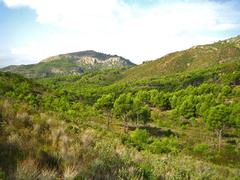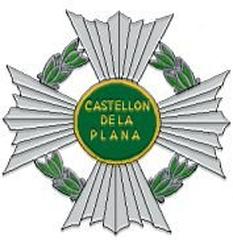Castell Vell Visitor Guide: Hours, Tickets, and Historical Insights
Date: 18/08/2024
Introduction
Nestled atop La Magdalena hill in Castelló De La Plana, Spain, Castell Vell is a site brimming with historical significance and architectural marvels. This ancient castle offers visitors a unique glimpse into the rich tapestry of the region’s history, from its Neolithic origins through its Islamic and Christian eras. Castell Vell stands as a testament to the strategic acumen and cultural heritage of its builders, reflecting the various civilizations that have left their mark on this land. The castle’s architecture, largely influenced by Islamic construction techniques, showcases its historical importance and enduring legacy. This guide aims to provide comprehensive insights into visiting Castell Vell, including its history, ticket information, visiting hours, and practical tips to enhance your exploration of Castelló De La Plana’s historical gem. Whether you are a history enthusiast, a photography lover, or simply seeking a tranquil retreat, Castell Vell promises a memorable experience. (Castlepedia, Arkeotour)
Table of Contents
- Introduction
- Origins and Early Inhabitants
- Islamic Influence and Architectural Marvels
- Strategic Importance
- The Decline of Al-Andalus and Christian Conquest
- Castell Vell as a Cultural Treasure
- The Hermitage of La Magdalena
- Restoration and Preservation Efforts
- Visitor Experience and Practical Tips
- FAQ
- Conclusion
Origins and Early Inhabitants
Castell Vell, perched atop La Magdalena hill, marks the origins of Castellón de la Plana. The earliest traces of human activity in this area date back to the Neolithic era, indicating that the hill has been a strategic and inhabited location for thousands of years. The site’s continuous occupation through various historical periods underscores its importance in the region’s development.
Islamic Influence and Architectural Marvels
The most prominent phase in Castell Vell’s history began in the 10th or 11th century when it was constructed by the Moors. The castle’s architecture is a testament to Islamic construction techniques, primarily using mud and masonry. Despite subsequent Christian interventions, the structure has largely retained its original form. The castle comprises three distinct parts: the Alcazaba (upper fortress), the Albacar (enclosure), and the hermitage of La Magdalena. The Alcazaba features remnants of walls and semicircular towers, reflecting the grandeur of its past (Castlepedia).
Strategic Importance
Castell Vell’s location on La Magdalena hill provided a strategic vantage point, crucial for controlling the surrounding territories. The castle was situated on a route connecting Valencia with Aragón, making it a pivotal site for monitoring and defending the region. Its position allowed control over vital watercourses, such as the Palancia and Canales rivers, showcasing the strategic acumen of its builders (Castlepedia).
The Decline of Al-Andalus and Christian Conquest
The decline of Al-Andalus and the subsequent Christian conquest significantly impacted Castell Vell. The castle witnessed numerous battles and changes in control, reflecting the turbulent history of the region. The Christian conquest, led by King James I in 1233, marked a turning point. The territory was divided between Almassora and Castelló, and the granting of the Transfer Privilege in 1251 led to the establishment of the city of Castelló. This historical event is commemorated annually in the “Romeria de les Canyes” (Pilgrimage of the Canes) since 1375 (Arkeotour).
Castell Vell as a Cultural Treasure
Beyond its military and strategic significance, Castell Vell serves as a cultural treasure, offering insights into the region’s rich heritage. The castle and its surroundings function as a living museum, providing a deeper understanding of the various civilizations that have left their mark on this land. Events and exhibitions held at the site further enhance its educational value, making it an essential destination for those interested in the history and culture of the Valencian Community (Castlepedia).
The Hermitage of La Magdalena
Adjacent to the castle ruins is the hermitage of La Magdalena, a sanctuary carved in stone. This hermitage is not only a place of religious significance but also a symbol of the region’s resilience and cultural diversity. The serene environment of the hermitage, combined with the panoramic views from the hill, offers a unique experience for visitors, blending historical exploration with spiritual reflection (Castlepedia).
Restoration and Preservation Efforts
Recent restoration efforts have aimed to preserve the historical integrity of Castell Vell while making it accessible to the public. These restorations are considered a new phase in the castle’s long history, ensuring that future generations can continue to explore and learn from this significant site. The architectural ensemble of Castell Vell is regarded as “built history,” where each restoration phase adds to its rich narrative (MUCC).
Visitor Experience and Practical Tips
Opening Hours and Ticket Information
The Centre d’Interpretació Castell Vell provides additional resources and information for visitors. The summer opening hours (from April 1st to September 30th) are from Tuesday to Saturday, 10:00 to 13:00 and 17:00 to 20:00, and on Sundays and bank holidays from 10:00 to 14:00. Winter opening hours (from October 1st to March 31st) are from Tuesday to Saturday, 10:00 to 14:00 and 16:00 to 18:00, and on Sundays and bank holidays from 10:00 to 14:00. The centre is closed on January 1st and 6th, and December 6th and 25th. For more information, visitors can contact Tourist Info Castelló.
Nearby Attractions and Accessibility
While visiting Castell Vell, you may also want to explore nearby attractions such as the Desert de les Palmes Natural Park and the city center of Castellón de la Plana. Public transportation options and parking facilities are available, making it easier for visitors to reach the site.
FAQ
Q: Is there an entrance fee to visit Castell Vell? A: No, entrance to Castell Vell is free.
Q: How long does it take to tour Castell Vell? A: The self-guided tour takes approximately 45 minutes.
Q: Is Castell Vell accessible for people with reduced mobility? A: Unfortunately, the site is not accessible for people with reduced mobility due to the uneven terrain.
Q: Are there guided tours available? A: Currently, there are no guided tours, but an audioguide and digital map are available for download from the MUCC website.
Conclusion
Castell Vell stands as a testament to the rich and diverse history of Castellón de la Plana. From its Neolithic origins to its role in the Islamic and Christian eras, the castle offers a unique glimpse into the past. Its strategic importance, architectural marvels, and cultural significance make it an essential destination for history enthusiasts and travelers alike. The ongoing preservation efforts ensure that Castell Vell will continue to inspire and educate future generations, maintaining its status as a cornerstone of the region’s heritage. Stay updated by downloading the Audiala mobile app or following on social media for more updates.




